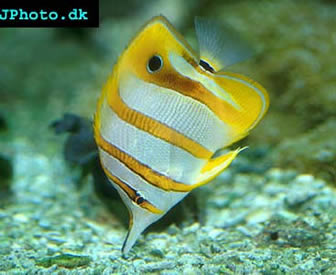Copperbanded Butterflyfish
Chelmon rostratus
Chelmon rostratus is known under several different common names in English, including
Copperbanded Butterflyfish, Copperband Butterflyfish, Copper-banded Butterflyfish,
Banded Longsnout Butterflyfish, Longnose Butterflyfish, Longnosed Butterflyfish, Beaked Butterflyfish, Beaked Coralfish, Breaked Coral Fish, Orange Stripe Butterflyfish, and Orange Stripe Butterfly.
Chelmon rostratus has not been evaluated for the IUCN Red List of Threatened Species.
Geographical range, habitat and habits
The Copperbanded Butterflyfish lives in the Western Pacific, from the Andaman Sea to the Ryukyu Islands and Australia. It is typically found along rocky shores and coral reefs, but can also be seen in estuaries and silty inner reefs. This species is territorial and live alone or in pairs. Its depth range is 1-25 meters / 3-82 feet.
Size and appearance
The largest scientifically measured Copperbanded Butterflyfish was 20 cm / 7.9 in.
This fish can be recognized on its long snout and yellow-orange (coppery) bands. The yellow-orange bars have black edging and run vertically across the body (they are clearly visible in the fins as well). The caudal peduncle is adorned with a blue-edged bar, while a dark-margined orange bar covers the eye. There is an ocellus (eye-spot) on the dorsal fin. Dorsal and anal fins are very tall.
The juveniles look similar to adult fish, but the long snout has not developed yet in juveniles and larvae. The fish has to settle on a reef before the long snout can start to develop.
Copperbanded Butterflyfish care
It is not advisable to keep Copperbanded Butterflyfish in an aquarium smaller than 75 gallons / 285 litres. The aquarium should contain a lot of suitable hiding spots as well as plenty of open space to swim around in. This is considered a medium difficult fish to keep.
The recommended water temperature is 72-78° F / 22-25.5° C. The pH-value should be in the 8.1-8.4 range and the specific gravity at 1.020-1.025. It is very important to keep the levels of organic waste really low.
The Copperbanded Butterflyfish is usually peaceful towards other fish and can be kept in friendly community aquariums. Juveniles will act as cleaner fish for larger fish. If you want to house several Butterflyfish together – regardless of species – you will need a very large and cleverly decorated aquarium because they are territorial towards each other. One alternative is to keep a compatible pair, another is to keep butterflyfish of very dissimilar sizes and introduce the smallest ones first. In the wild, you can find Copperbanded Butterflyfish in large schools and it is possible to keep them in schools in captivity as well, but this will of course require a really large aquarium.
The Copperbanded Butterflyfish is considered reef compatible with caution. It is known to pick at stony corals with large polyps and it will also eat Feather Dusters and Fanworms. It is often introduced to help fight glass anemones of the species Aiptasia pallida and Aiptasia pulchella in the aquarium.
Feeding Copperbanded Butterflyfish
It can be difficult to get the Copperbanded Butterflyfish to feed when introduced to a new aquarium. Try to entice it with tasty live food, such as mysid shrimps and freshly opened clams. Once it has begun to eat, you can gradually train it to accept fresh and frozen foods, such as crustacean flesh and shrimps. The Copperbanded Butterflyfish might devour the polyps of stony corals with large polyps in the aquarium, and feather dusters and fanworms might also end up as food. As mentioned above, it is also fond of certain anemones.
Feed your Copperbanded Butterflyfish several small portions throughout the day instead of just one or two major meals. It is important to keep the diet varied. In the wild, the Copperbanded Butterflyfish will use its long nose, narrow snout to find various types of food inside holes and crevices on the reef.
Breeding Copperbanded Butterflyfish
The Copperbanded Butterflyfish is an egg-laying species that scatters the eggs. It will form pairs during breeding.
Butterflyfish Articles:
Golden Butterflyfish – Chaetodon semilarvatus
Klien's Butterflyfish – Chaetodon kleinii
Lined Butterflyfish – Chaetodon lineolatus
Longfin Bannerfish – Heniochus acuminatus
Raccoon Butterflyfish – Chaetodon lunula
Saddleback Butterflyfish – Chaetodon falcula
Schooling Bannerfish – Heniochus diphreutes
Threadfin Butterflyfish – Chaetodon auriga
Yellow Longnose Butterflyfish – Forcipiger flavissimus

